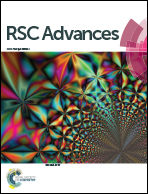Structural and thermal properties of Na2Mn(SO4)2·4H2O and Na2Ni(SO4)2·10H2O†
Abstract
The title compounds were prepared via a wet chemistry route and their crystal structures were determined from single crystal X-ray diffraction data. Na2Mn(SO4)2·4H2O crystallizes with a monoclinic symmetry, space group P21/c, with a = 5.5415(2), b = 8.3447(3), c = 11.2281(3) Å, β = 100.172(1)°, V = 511.05(3) Å3 and Z = 2. Na2Ni(SO4)2·10H2O also crystallizes with a monoclinic symmetry, space group P21/c, with a = 12.5050(8), b = 6.4812(4), c = 10.0210(6) Å, β = 106.138(2)°, V = 780.17(8) Å3 and Z = 2. Na2Mn(SO4)2·4H2O is a new member of the blödite family of compounds, whereas Na2Ni(SO4)2·10H2O is isostructural with Na2Mg(SO4)2·10H2O. The structure of Na2Mn(SO4)2·4H2O is built up of [Mn(SO4)2(H2O)4]2− building blocks connected through moderate O–H⋯O hydrogen bonds with the sodium atoms occupying the large tunnels along the a axis and the manganese atom lying on an inversion center, whereas the structure of Na2Ni(SO4)2·10H2O is built up of [Ni(H2O)6]2+ and [Na2(SO4)2(H2O)4]2− layers. These layers which are parallel to the (100) plane are interconnected through moderate O–H⋯O hydrogen bonds. The thermal gravimetric- and the powder X-ray diffraction-analyzes showed that only the nickel phase was almost pure. At a temperature above 300 °C, all the water molecules evaporated and a structural phase transition from P21/c-Na2Ni(SO4)2·10H2O to C2/c-Na2Ni(SO4)2 was observed. C2/c-Na2Ni(SO4)2 is thermally more stable than Na2Fe(SO4)2 and therefore it would be suitable as the positive electrode for sodium ion batteries if a stable electrolyte at high voltage is developed.



 Please wait while we load your content...
Please wait while we load your content...